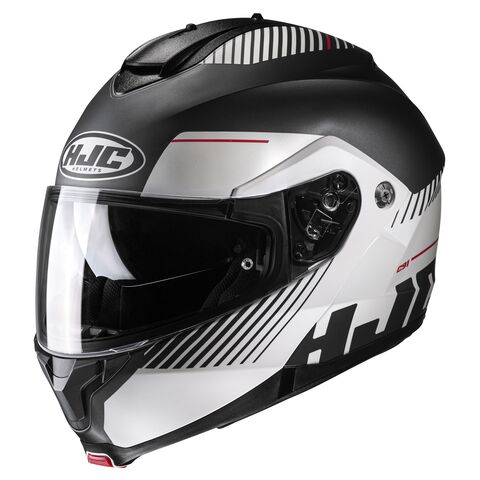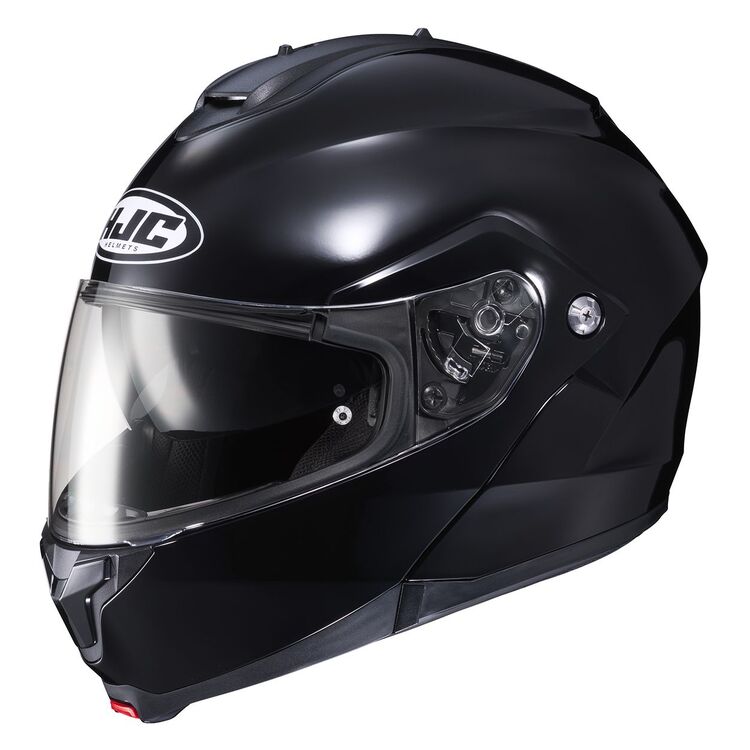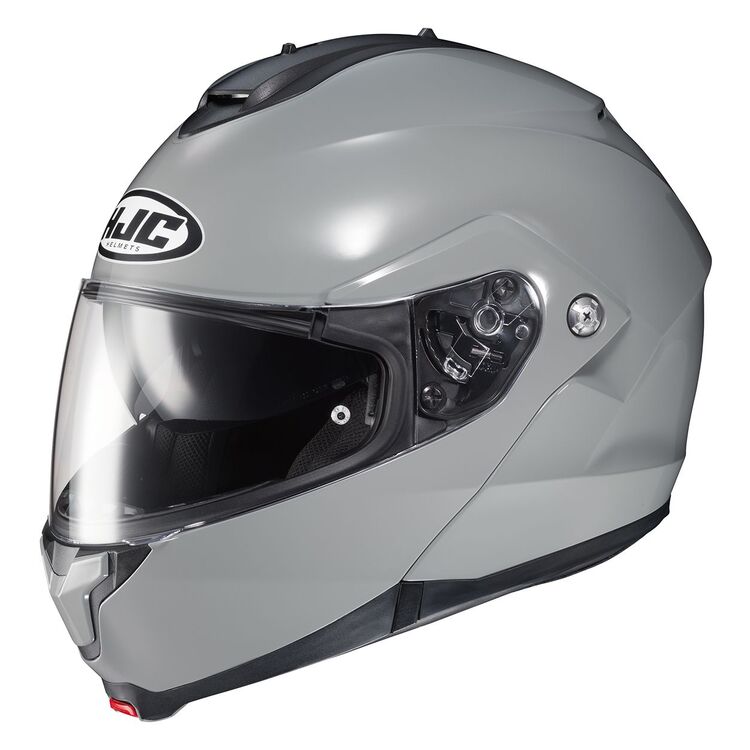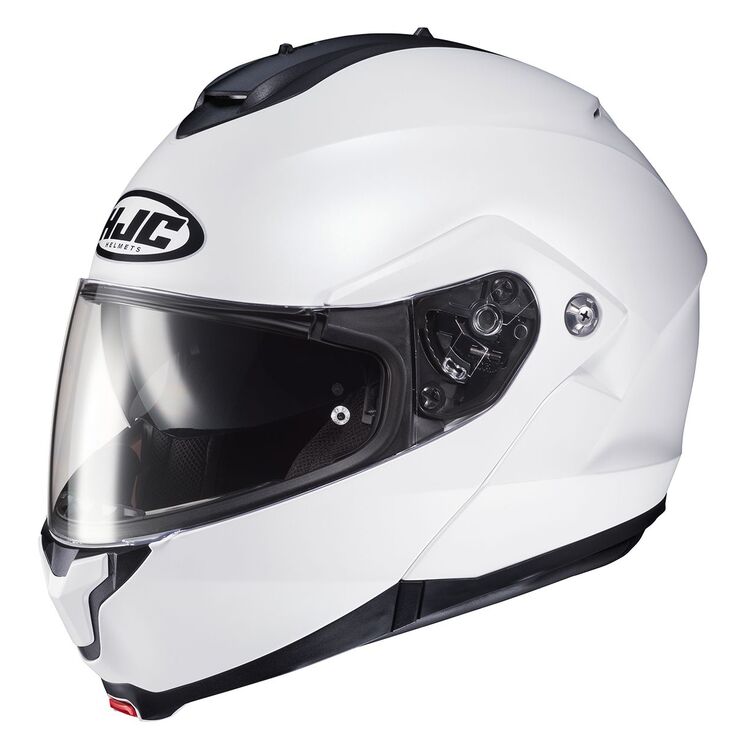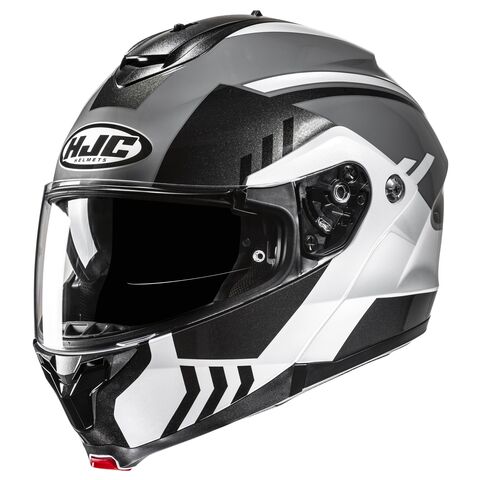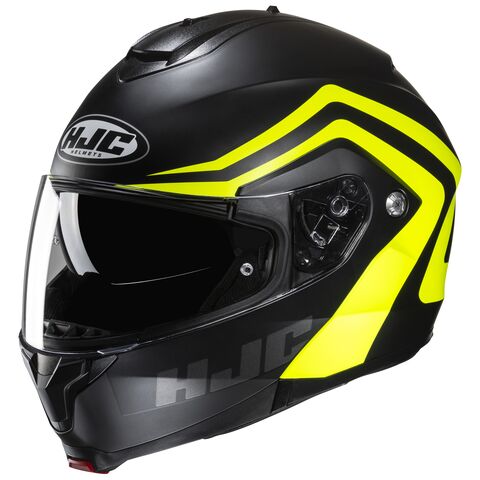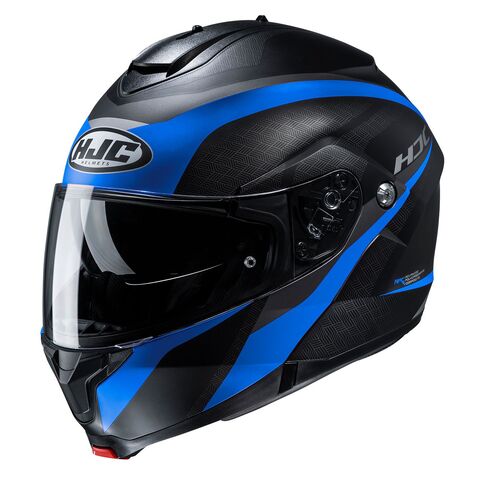Our HJC C91 Review answers budget-conscious riders’ questions about finding quality modular protection without breaking the bank.
I’ve tested countless modular helmets on everything from daily commutes to cross-country tours, searching for gear that delivers protection without a premium price tag.
Our HJC C91 review examines real-world performance to help you decide if this modular helmet delivers the value it promises.
Does this hjc c91 helmet really offer the superior fit, comfort, and reliability that commuters and touring riders need, or should you save up for something more expensive?
Our C91 Final Verdict
What I Like About the HJC C91
Comfort and Fit Features
HJC C91 helmet excels in superior fit comfort once the break-in period concludes; it “feels great and fits my head perfectly” after the initial tightness subsides.
The glasses groove design receives particular praise, with one user noting “no problem with this whatsoever” when wearing prescription eyewear.
The SuperCool interior and removable cheek pads make maintenance straightforward, with users liking that “liners are easy to remove and reinsert, making cleaning a breeze”.
The helmet accommodates riders with round-oval head shape configurations who struggle with other brands.
The easy-use flip-up mechanism operates smoothly even with gloves, making gas stops and conversations convenient.
The advanced channeling ventilation system provides adequate airflow for most riding conditions, which is great for having all-around ventilation.
Integrated Features and Technology
Smart HJC-ready compatibility receives positive feedback from users who appreciate the dedicated mounting points and clean integration with HJC Bluetooth systems.
The integrated sun visor provides convenience for changing light conditions, though it works better as a supplementary feature rather than primary eye protection.
The Pinlock-ready visor preparation allows fog prevention upgrades, and the RapidFire shield replacement system makes maintenance simple.
The speaker pockets accommodate both HJC and third-party Bluetooth systems effectively. The 20b Bluetooth system integration maintains the helmet’s aerodynamic profile while providing communication capabilities.
The variety of color options and graphics allows personalization, with users particularly liking options like the Taly design with its distinctive striped bands.
What I Dislike About the HJC C91
Sizing and Initial Comfort Issues
HJC C91 helmet runs smaller than typical helmet sizing, forcing some people to order one size up to avoid discomfort.
The initial cheek pad tightness creates problems that persist beyond normal break-in periods. It has a “very snug” fit that requires replacement with thinner pads, causing discomfort for the first couple of weeks.
The cheek pads can remain problematic even after extended use, with some riders needing to purchase thinner replacement pads to achieve a comfortable fit.
Visible marks and jaw pain after 20-30 minutes of riding can occur when the pads remain too tight. The break-in process doesn’t always resolve the pressure issues.
Fogging and Visibility Problems
HJC C91 helmet lacks effective anti-fog properties without a Pinlock insert, creating serious visibility issues during humid conditions. The visor can steam up, making it difficult to ride with the visor down.
The Pinlock insert sits low and doesn’t cover the full visor height, leaving about an inch of visor above it and creating a visible horizon line.
The sun visor presents optical quality problems, being “not optically correct” and causing “wavy and distorted” vision, particularly at the edges.
The sun shield operation through the top-mounted slider feels awkward initially, and some users report it can sit low enough to contact their noses during rides.
The manual operation eliminates spring failures but creates ergonomic challenges that some riders never fully adapt to.
Noise and Wind Issues
HJC C91 helmet generates noticeable wind noise that becomes problematic at highway speeds; it is “a bit noisy but comfortable so. I would recommend earplugs for longer rides”.
Hearing Bluetooth speakers on the highway can be difficult due to wind noise levels.
Air leaks around the visor and turbulent airflow can create buffeting at speed. The helmet performs acceptably at city speeds but becomes fatiguing during extended highway use where wind noise dominates the riding experience.
Modifications like adding foam padding and tape could reduce noise levels, indicating the stock configuration doesn’t adequately address acoustic issues.
Build Quality and Durability Concerns
HJC C91 helmet shows quality control inconsistencies, such as missing fabric helpers for chin straps and wrinkles in plastic components around the collar.
The sun visor mechanism and vent levers are “vulnerable” and could potentially break if caught accidentally during normal use. Visor attachment point wear can cause unexpected detachment during rides.
The DuPont snap system for liner attachment requires significant effort to engage properly and may wear over time, potentially requiring replacement snaps.
The air vents are “pretty useless” and don’t provide adequate airflow control. The visor sealing around the bottom allows constant air to blow directly on the nose, creating comfort issues during rides.
Specifications:
- DOT Approved
- Advanced polycarbonate composite shell
- HJ-17 Pinlock-ready face shield (Pinlock insert sold separately)
- HJ-V5 drop-down inner sun visor
- SuperCool interior
- Glasses groove integrated into cheek pads
- Speaker pockets for Bluetooth communication
- Direct compatibility with SmartHJC 10b or 20b Bluetooth systems (sold separately)
Comparison to Similar Models
| Model Name (with Link) | Weight (lbs) | Safety Certifications | Bluetooth | Noise Levels |
|---|---|---|---|---|
| HJC C91 Modular Helmet | 3.53 | ECE 22.06, DOT | Ready for HJC Smart 10B/20B (sold separately) | Average for modular helmets |
| HJC I91 Modular Helmet | 3.53 (varies by size) | ECE 22.05, DOT | Ready for HJC Smart 10B/20B (sold separately) | Moderate; not known for quietness |
| HJC I100 Flip-Up Helmet | 3.85 (varies by size) | ECE 22.05, DOT | Ready for HJC Smart 10B/20B (sold separately) | Louder than other models; more wind noise |
| HJC RPHA 91 (Quietest Flip-Up) | 3.75 | ECE 22.06, DOT | Ready for HJC Smart 10B/20B (sold separately) | Among the quietest modular helmets; superior noise reduction |
This table provides a clear, concise comparison of the key features and specifications for these HJC modular helmets.
HJC C91 Shell Materials
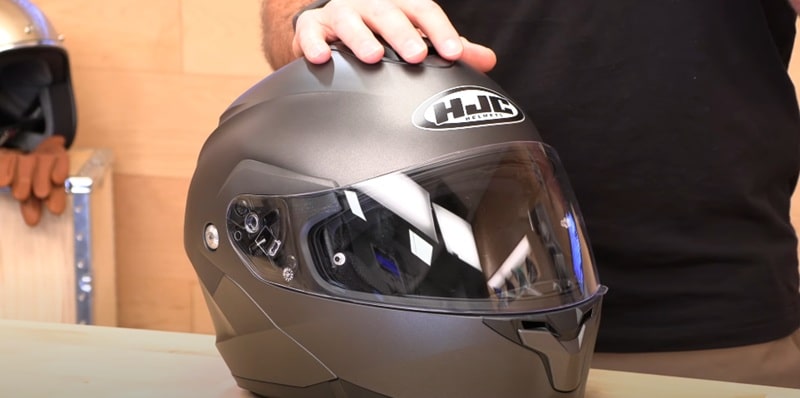
HJC C91 helmet uses a polycarbonate composite shell that balances cost and protection. This material choice makes the helmet accessible while still meeting safety requirements.
The C91’s predecessor, the C90, earned a 4-star SHARP safety rating, and HJC confirmed the C91 is “further reinforced for optimal impact protection”.
The polycarbonate composite shell construction does come with trade-offs, requiring more bulk to achieve the same protection levels as premium alternatives, potentially making the helmet heavier than fiberglass or carbon fiber options.
HJC C91 Modular Chin Bar Mechanism
The modular chin bar mechanism on the C91 operates with easy use – you can flip it up or down even while wearing gloves.
The latching system engages reliably, though some riders might need to give it a small pinch to ensure it clicks shut properly.
The chin bar on both helmets is designed for easy operation, even with gloves. The C91’s latches engage without issue, though some users might manually ensure they click shut. This reliable latching system provides both safety and convenience.
The C91 has “pretty typical of HJC” utilitarian styling – not as subtle as premium brands but not overly aggressive.
HJC gave the C91 a redesign from the C90 with “more rakish angles,” creating a functional and straightforward aesthetic without the “in-your-face” aggressive styling of some other brands.
HJC C91 Head Shape and Fit
The HJC C91 helmet is specifically a “round-oval” helmet, a shape that can be challenging to find in the US market.
This provides superior fit comfort for riders with this head shape by avoiding hot spots common with intermediate oval helmets.
The round-oval design fills a specific market niche, offering superior comfort for those riders.
This contrasts with the i91 model, which has an “intermediate oval” shape suitable for the majority of riders, though some users with rounder heads found it suitable too, suggesting a broader appeal.
HJC C91 Sizing Tendencies
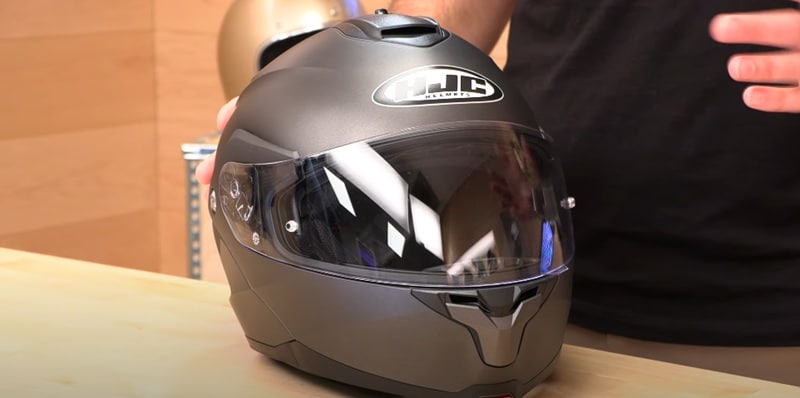
HJC C91 helmet is notorious for running small compared to typical helmet sizing expectations. Customers consistently report needing to size up when they’re between sizes.
RevZilla specifically notes that “customers have found this helmet to run small and recommend sizing up if in between sizes”.
The snug initial fit allows the helmet to mold properly to your head shape during the break-in period. This contrasts sharply with the HJC i91, which fits true to size with remarkable consistency.
The i91 boasts a very low 2% return rate for size swaps, suggesting that riders get exactly what they expect from the sizing chart.
But here’s where it gets tricky for C91 buyers – you must be mindful of sizing up to avoid discomfort that can be alarming to new users.
The initial tightness can feel wrong even though it’s designed to subside. The i91’s consistent sizing aligns with typical expectations, making it easier for riders to choose confidently from the sizing chart.
Initial Tightness and Break-in
HJC C91 helmet should feel tight initially, especially around the cheek pads. This isn’t a defect – it’s intentional design.
Both the C91 and i91 helmets are engineered to fit snugly when new, then gradually conform to your specific head shape over the first few rides.
The SuperCool interior lining and cheek pad materials are designed to compress and mold during this break-in period.
The break-in process typically takes about a week of regular riding, with cheek pads compressing by approximately a quarter inch.
This creates superior fit comfort once the helmet adapts to your face contours. HJC offers different thickness cheek pads for custom adjustments, and these cheek pads are interchangeable throughout all helmet size options.
But the C91 presents a particular challenge that some riders find concerning. Even after extended use, some users report that cheek pads remained uncomfortably tight, requiring them to purchase thinner replacement pads.
This can be frustrating when you’ve already sized up and still experience pressure points. The helmet’s polycarbonate composite shell construction contributes to this issue, as the shell doesn’t flex as premium materials might.
HJC C91 Outer Shell Sizes
The HJC i91 features three distinct outer shell sizes that optimize both aesthetics and superior fit comfort.
The shell sizes break down as XS-S, M-L, and XL-XXL, which helps maintain proper proportions across the size range.
This approach prevents the “lollipop effect,” where smaller heads look disproportionate in oversized shells. The three-shell design of the i91 contributes to better weight distribution and aerodynamics for each head shape.
Official Sizing Chart
HJC C91 helmet follows the standard HJC sizing convention, but this modular helmet runs small. Here’s the official sizing chart that applies to the C91:
| Size | Head Circumference (cm) | Head Circumference (inches) | Hat Size |
|---|---|---|---|
| XS | 54-55 | 21 1/4 – 21 5/8 | 6 3/4 – 6 7/8 |
| S | 55-56 | 21 5/8 – 22 | 6 7/8 – 7 |
| M | 57-58 | 22 1/2 – 22 7/8 | 7 1/8 – 7 1/4 |
| L | 58-59 | 22 7/8 – 23 1/4 | 7 1/4 – 7 3/8 |
| XL | 60-61 | 23 5/8 – 24 | 7 1/2 – 7 5/8 |
| 2XL | 62-63 | 24 3/8 – 24 3/4 | 7 3/4 – 7 7/8 |
| 3XL | 64-65 | 25 1/4 – 25 5/8 | 8 – 8 1/8 |
| 4XL | 66-67 | 26 – 26 3/8 | 8 1/4 – 8 3/8 |
| 5XL | 68-69 | 26 3/4 – 27 1/8 | 8 1/2 – 8 5/8 |
Critical Sizing Information
HJC C91 helmet runs smaller than typical helmet size expectations. Customers consistently report needing to size up when they’re between sizes.
How to Measure Your Head
HJC helmets require accurate head measurement for proper fit comfort using the right size. Wrap a cloth measuring tape around your head just above your eyebrows and ears.
Pull the tape comfortably snug, read the measurement, and repeat for accuracy – use the largest measurement.
The measurement should be taken at the widest point of your head, approximately 1 cm above the ears. This gives you the head circumference that corresponds to the sizing chart above.
HJC C91 Interior
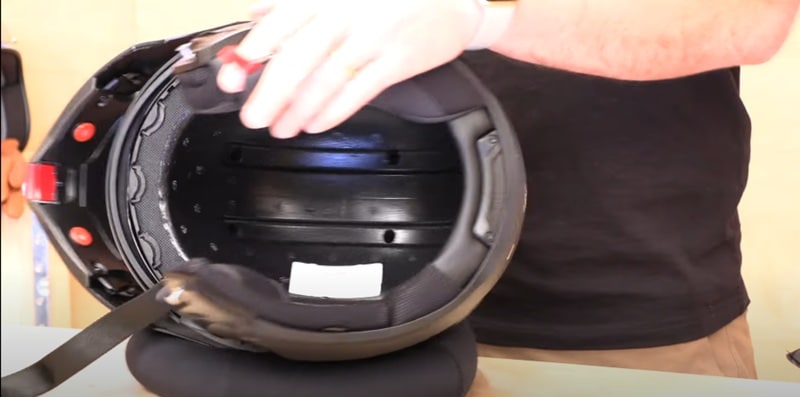
HJC C91 is built with HJC’s SuperCool interior that delivers moisture-wicking and anti-bacterial properties for extended riding comfort.
This material keeps you fresh during hot rides by pulling sweat away from your skin and preventing odor buildup.
The SuperCool lining works well for long touring sessions, though it doesn’t match the plush feel of premium brands or HJC’s RPHA line.
The liner quality stays decent rather than outstanding – it’s functional without being luxurious compared to higher-end options.
The anti-bacterial fabric helps maintain hygiene during regular use, and the removable nature makes maintenance straightforward.
The comfort of using advanced materials shows up in the moisture management, though the overall feel remains budget-focused rather than premium.
Cheek Pads
The HJC c91 helmet features removable cheek pads and crown padding that you can wash when needed.
The cheek pads are interchangeable throughout all helmet size options, which means you can customize the fit by swapping different thickness pads.
Glasses Grooves
HJC C91 helmet includes integrated glasses grooves in the cheek pads that accommodate riders who wear prescription eyeglasses and sunglasses.
These grooves create dedicated channels that prevent your glass’s arms from getting pinched against your head during rides.
The design works well for most spectacle wearers, reducing pressure points that typically cause discomfort with standard helmet interiors.
The grooves handle different frame thicknesses reasonably well, though comfort still depends on your specific glasses design.
The superior fit comfort comes from HJC’s understanding that many riders need prescription eyewear while riding.
But the C91’s glasses accommodation, while effective, doesn’t reach the level of the HJC i91 model.
The i91 is noted as “the most accommodating helmet I can remember wearing” for glasses users.
The C91 handles glasses adequately without the refined comfort that more expensive helmets provide.
You’ll find it works for daily riding, though riders with thicker frames might experience some pressure after long rides.
HJC C91 Ventilation and Airflow
HJC C91 helmet features an advanced channeling ventilation system with one closable chin bar vent, one closable forehead vent with three positions, and two always-open exhaust vents.
The channeling ventilation system moves air through the helmet’s deep EPS channels to keep you cool during rides.
The forehead vent delivers good upper-head airflow, while the large top vent allows effective air circulation at highway speeds.
The chin bar vent mechanism operates smoothly with a “clicky” feel that works even with gloves on.
But, the chin vent’s airflow direction isn’t optimized for de-fogging your visor, which can be problematic during humid conditions or temperature changes.
The system works best at high speeds where the forced airflow compensates for the vent positioning limitations.
The advanced channeling design makes the C91 effective as a four-season helmet that handles varying weather conditions.
The airflow performs adequately at low speeds, though it’s not impressive compared to dedicated sports helmets.
You can adjust the vents based on riding conditions – close them for cold weather riding or open everything for summer touring. The two exhaust vents stay open constantly to pull warm air out the back.
| Ventilation Feature | C91 Performance | User Feedback |
|---|---|---|
| Chin Vent | Not well-directed for defogging | Works with gloves, limited effectiveness |
| Top Vent | Good upper-head airflow | Effective at highway speeds |
| Exhaust Vents | Two always-open rear ports | Adequate heat extraction |
| Overall Airflow | Mediocre at low speeds | Four-season capability |
HJC C91 Visor
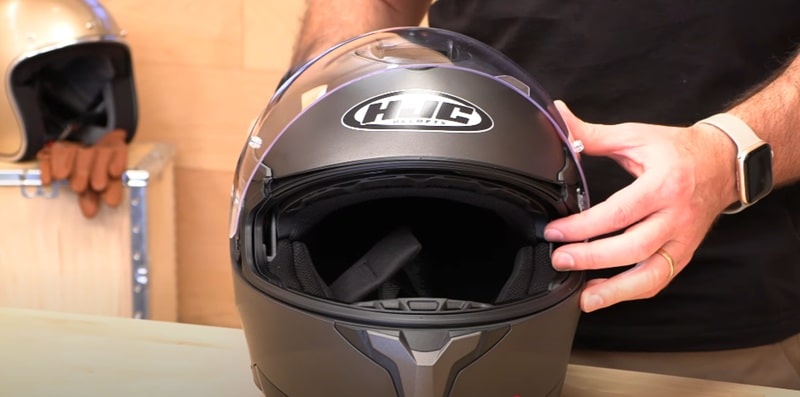
HJC C91 helmet is equipped with a Pinlock-ready HJ-17 face shield that delivers 99% UV protection but lacks built-in anti-fog properties.
The main shield fogs easily without a Pinlock insert, making this aftermarket addition practically necessary for most riding conditions.
You’ll need to budget around $30-40 USD for a Pinlock insert since the HJC C91 helmet doesn’t include one in the box.
The face shield features a quick-release RapidFire system that allows tool-free visor changes with easy use even while wearing gloves.
The shield construction offers excellent durability and scratch resistance, making it ideal for daily riding. But the C91’s visor mechanism has a notable limitation.
The first detent opens the visor about an inch, meaning you can’t get that subtle “crack” opening for minimal airflow. This forces you to choose between fully closed or significantly open positions.
The smart hjc-ready design accommodates Bluetooth sold separately systems without interfering with visor operation.
The Pinlock-ready preparation means you can add fog prevention, but it’s an extra expense that competing models like the HJC i91 include in the box.
Sun Visor
HJC C91 helmet incorporates a drop-down internal sun visor with a top-mounted slider mechanism that feels awkward initially but prevents interference with communication mounts.
The manual operation eliminates the spring failure issues that plagued earlier HJC models, giving you reliable long-term performance. The sun shield deploys and retracts smoothly once you adapt to the top-mounted control location.
But the C91’s sun visor presents a serious optical quality problem – it’s not optically correct, causing “wavy and distorted” vision, particularly at the edges.
This distortion can be disorienting during rides, especially when scanning for traffic or navigating curves. The sun shield also sits low enough to contact some riders’ noses, creating pressure points during extended wear.
The integrated sun protection offers convenience for changing light conditions without needing to swap visors or wear separate sunglasses.
The anti-scratch coating helps maintain visibility over time, and the manual mechanism won’t leave you stuck with a sun visor that won’t retract.
The HJC i91 offers a more refined sun shield experience with left-side operation and adjustable depth coverage, but the C91’s approach prioritizes durability over sophistication.
| Visor Feature | HJC C91 | HJC i91 |
|---|---|---|
| Pinlock Included | No, $30-40 extra cost | Yes, included in box |
| Anti-fog Properties | Nonexistent without Pinlock | Good with included Pinlock |
| First Detent Opening | About 1 inch, no subtle crack | Standard gradual opening |
| Sun Visor Operation | Top-mounted slider | Left-side switch |
| Sun Visor Optics | Not optically correct, distorted | Better optical quality |
| UV Protection | 99% UVA/UVB | 99% UVA/UVB |
The lightweight helmet design means the visor system doesn’t add unnecessary weight, but the optical compromises in the sun visor make it less suitable for riders who prioritize clear vision over cost savings.
The good reviews for the C91 often mention the visor system as functional but not refined compared to premium alternatives.
HJC C91 Helmet Noise Levels
The HJC C91 helmet noise levels are about average for a modular lid when compared to other flip-up designs.
The lightweight helmet construction contributes to its acoustic characteristics, but the polycarbonate composite shell doesn’t provide the same noise-dampening as premium materials.
The helmet performs better at city speeds compared to highway riding, where wind noise becomes more prominent.
But when you compare the C91 to its sibling, the HJC i91, the difference becomes clear. The i91 recorded an average of 105 decibels during controlled testing at 130 km/h, which classifies it as “pretty loud” according to professional helmet testing standards.
This puts the i91 in the louder category of modular helmets, earning just 2 out of 5 stars for noise isolation.
Some users report that the i91’s noise becomes particularly noticeable and fatiguing during highway use, lasting more than an hour.
The smart HJC-ready design and Bluetooth sold separately compatibility mean you can add communication systems, but these won’t mask the underlying wind noise issues.
The 105-decibel measurement for the i91 places it well above the 85-decibel threshold, where hearing damage can occur with prolonged exposure.
Professional testing shows that quiet helmets measure around 97 decibels, average helmets hit 100 decibels, and noisy helmets reach 104+ decibels.
Noise Reduction Tips
HJC C91 helmet users should consistently wear good earplugs to mitigate noise levels during rides, especially at highway speeds where wind noise dominates.
The easy use of quality motorcycle earplugs can reduce noise exposure by 15-25 decibels, bringing potentially damaging levels down to safer ranges.
Alpine MotoSafe and similar motorcycle-specific earplugs are designed to attenuate wind noise while preserving your ability to hear important traffic sounds.
The C91 benefits from aftermarket chin curtains that help reduce wind and noise inside the helmet.
These curtains create a better seal around the neck area, preventing turbulent air from entering the helmet’s lower opening.
The channeling ventilation system design means that while vents provide airflow, they also contribute to noise when fully open.
You can manage this by adjusting vent positions based on riding conditions – closing vents in cold weather reduces noise while opening them in hot weather prioritizes cooling over the quiet operation.
But even with earplugs and chin curtains, the noise level might be a deal-breaker for riders who prioritize quietness above all else.
The good reviews for the C91 often mention that riders need to accept the noise of modular helmets as part of the trade-off for convenience.
Some forum users report that HJC helmets tend to be noisier than competitors, with one rider noting they “find HJCs to be really noisy” compared to other brands.
The scientific data shows that motorcycle helmet wind noise can reach 115 decibels at highway speeds, and any noise above 85 decibels can cause hearing damage with prolonged exposure.
Research from the University of Southampton found that noise levels under motorcycle helmets range from 78-90 dB at 30 mph to 114-116 dB at 120 mph, depending on the helmet and motorcycle combination. Simple modifications like improved neck seals can reduce noise levels by 5-8 decibels.
| Noise Management Strategy | Effectiveness | Cost |
|---|---|---|
| Quality Earplugs | 15-25 dB reduction | $15-40 USD |
| Chin Curtain | 3-5 dB reduction | $10-20 USD |
| Proper Helmet Fit | 2-4 dB reduction | Included |
| Neck Gaiter/Scarf | 2-3 dB reduction | $10-25 USD |
The 20b Bluetooth system integration can help mask wind noise through audio content, but it doesn’t address the underlying acoustic issues.
Professional riders and motorcycle couriers who face daily noise exposure often combine multiple strategies – earplugs, chin curtains, and proper helmet fit – to create a safer acoustic environment.
The key is understanding that no single solution will make a modular helmet as quiet as a premium full-face design, but combining approaches can make the hjc c91 helmet manageable for most riding situations.
HJC C91 DOT and ECE 22.05 Safety Certifications
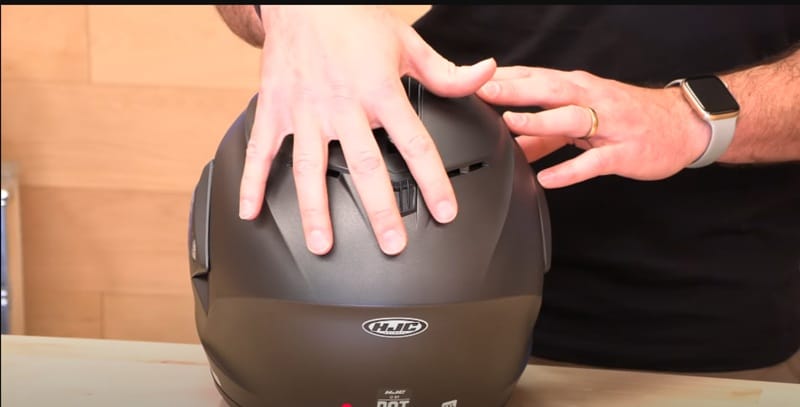
HJC C91 helmet is DOT-approved in the US and ECE 22.05 certified in Europe, meeting mandatory safety standards for road use.
The DOT certification follows FMVSS 218 standards, which include energy attenuation, penetration resistance, and chin strap structural integrity testing.
The ECE 22.05 certification allows you to ride legally in around 50 countries worldwide and requires more rigorous testing protocols than DOT standards.
The HJC c91 helmet underwent testing that includes impact absorption at 7.5 meters per second with specific energy transfer limits.
But, the C91 lacks a SHARP rating, which is a key independent safety test conducted in the UK. The HJC i91, by contrast, meets the more stringent ECE 22.06 standard along with DOT certification.
The ECE 22.06 certification indicates a higher level of impact protection testing with 12 impact points compared to the 6 points tested in ECE 22.05.
The newer standard also includes rotational impact testing and more demanding speed requirements.
Chin Bar Security
HJC C91 helmet benefits from HJC’s strong track record for chin bar security in their modular helmet designs.
The C90, which is the C91’s predecessor, achieved an 87% score for its chin bar staying closed during SHARP impact testing.
HJC modular chin bars across multiple models have an average SHARP score of 92% for staying locked over 150 impact tests.
HJC confirmed the C91 is “further reinforced for optimal impact protection” compared to its predecessor, which suggests improved chin bar retention characteristics.
The good reviews often mention the reliable chin bar mechanism that operates with easy use even while wearing gloves.
But an 87% or 92% retention rate, while decent for the industry, isn’t 100%. Some riders might prefer maximum chin bar security, and this gap means there’s still a small chance of chin bar disengagement during severe impacts.
The smart hjc-ready design accommodates Bluetooth sold separately systems without compromising the chin bar locking mechanism.
The P/J certification distinguishes between “Protective” (full-face) and “Jet” (open-face) configurations.
The i91’s ECE 22.06 standard includes this dual testing requirement, which wasn’t mandatory under the older ECE 22.05 standard.
This legal validation allows you to ride with the chin bar up for gas stops, conversations, or cooling without violating helmet regulations.
The HJC C91 helmet doesn’t offer the same legal flexibility for riding with the chin bar open.
The C91 was designed specifically to be used in the closed chin bar position, and HJC specifies that all helmet fitting should be done while the chin bar is closed and locked.
This limitation means you can’t legally ride with the chin bar up in jurisdictions that require proper certification for open-face use.
MIPS Technology Gap
HJC C91 helmet doesn’t include MIPS (Multi-directional Impact Protection System) technology, which represents a potential gap for riders seeking advanced rotational impact protection.
But the absence of MIPS doesn’t mean the HJC c91 helmet lacks adequate protection for most riding scenarios.
The polycarbonate composite shell and multi-density EPS liner provide effective linear impact protection that meets current safety standards.
You can still get solid protection at a reasonable price, though riders specifically seeking rotational impact protection might consider other options.
| Safety Feature | HJC C91 | HJC i91 |
|---|---|---|
| DOT Certification | Yes | Yes |
| ECE Standard | 22.05 | 22.06 |
| SHARP Rating | Not tested yet | Not tested yet |
| Dual Homologation | No | Yes (P/J) |
| MIPS Technology | No | No |
| Chin Bar Retention | Estimated 87-92% | Estimated 87-92% |
HJC C91 Helmet Weight
HJC C91 helmet is heavier than competitors like the Bell Qualifier, with a size Large averaging 3 lbs 13.1 oz (1733 grams) compared to the Qualifier’s 3 lbs 6.9 oz (1527 grams).
This lightweight helmet category placement becomes relative when you consider that the hjc c91 helmet still falls within acceptable ranges for modular helmet designs.
The polycarbonate composite shell construction contributes to this weight difference, but the trade-off delivers affordability and decent protection for commuting and touring applications.
But when you compare the C91 to the HJC i91, the weight story gets more complex. The i91 weighs 4 lbs 0.5 oz (1827 grams) for a medium size, making it “heavy even for a polycarbonate helmet”.
This puts the i91 in the heavyweight category for flip-up helmets, though some users report that the balanced weight distribution makes it feel less cumbersome during actual riding.
The Bell Qualifier serves as a useful benchmark because it represents quality polycarbonate construction at a lower weight point.
The Qualifier’s 3 lbs 6.9 oz (1527 grams) demonstrates that lighter options exist, but you sacrifice the modular convenience that makes the smart HJC-ready C91 appealing for urban riding and touring.
Weight Performance
HJC C91 helmet performs acceptably for commuting and touring despite its heavier mass compared to traditional full-face alternatives.
The superior fit comfort comes from balanced weight distribution that prevents the top-heavy sensation common in poorly designed modular helmets.
The helmet’s weight becomes less noticeable once you’re moving, especially during highway riding, where aerodynamics helps mask the mass.
But the C91’s weight becomes problematic for specific riding scenarios. Off-road use isn’t recommended due to the additional neck strain during jumps, quick head movements, and extended riding periods.
Research shows that heavy helmets can increase muscle fatigue and reduce range of motion, making them unsuitable for motocross or adventure riding, where quick head checks are critical.
The weight factor also affects long-distance comfort. The helmet can feel “rather heavy for longer rides,” though this varies significantly based on individual neck strength and riding position.
HJC C91 Helmet Bluetooth Options
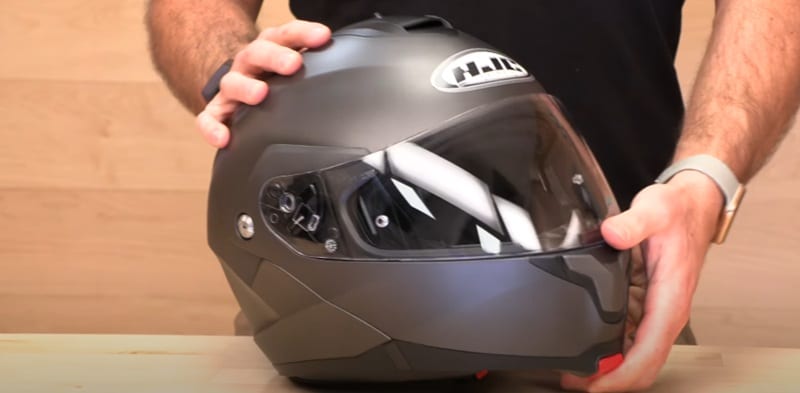
HJC C91 helmet is smart HJC ready for integration with HJC’s proprietary Sena-developed Bluetooth systems, specifically the 10B and 20B models.
The hjc c91 helmet features dedicated slots for battery packs positioned at the back of the helmet, along with specific mounting locations for the computer module, speakers, and microphone components.
The 20b Bluetooth system costs approximately $300 USD and provides 8-way intercom capability with Bluetooth 4.1 technology, while the 10b 20b Bluetooth entry-level model costs around $140 USD with basic 1:1 intercom functionality.
The smart hjc-ready integration delivers a sleek mounting method that’s less prone to noise compared to external clamp-on systems.
The HJC units co-developed with Sena offer voice command, FM radio, and music-sharing capabilities while maintaining the helmet’s aerodynamic profile.
But the smart hjc-ready approach means that the Bluetooth is sold separately – you’re looking at an additional cost that can nearly double the helmet’s price when adding the 20b Bluetooth system.
The easy-use installation requires removing cheek pads and threading wires through dedicated channels, which takes more time than simple clamp-on alternatives.
The proprietary nature of the smart HJC-ready system also limits your future upgrade options to HJC’s ecosystem rather than allowing brand flexibility.
Third-Party Compatibility
HJC C91 helmet accommodates most third-party communication kits through its internal speaker pockets and wiring channels, giving you the flexibility to choose preferred brands like Cardo or Sena.
The modular helmet design includes dedicated speaker recesses and microphone routing that works with standard Bluetooth headsets.
This compatibility allows you to use existing communication systems when upgrading from other helmets, saving money on redundant purchases.
The third-party flexibility means you can select from brands like Cardo PackTalk or Sena models based on your specific needs and budget preferences.
Cardo systems offer mesh networking capabilities, while Sena provides different feature sets at various price points.
The good reviews from users confirm that installation is generally straightforward with most major brands.
But the C91’s oval speaker pockets present challenges for larger speakers, particularly 45mm JBL drivers commonly used in premium Cardo systems.
The shallow, oblong shape of the speaker recesses means you might need to modify foam padding or use thinner speakers to prevent pressure on your ears.
The microphone wiring channel can also be too small for some boom microphones, requiring careful routing or minor modifications for optimal fit.
Some users report needing to remove factory Velcro strips to achieve comfortable speaker placement with third-party systems.
| Bluetooth Option | Cost | Installation | Features | Compatibility |
|---|---|---|---|---|
| Smart HJC 10B | $140 USD | Integrated mounting | 1:1 intercom, FM radio | C91 specific |
| Smart HJC 20B | $300 USD | Integrated mounting | 8-way intercom, voice command | C91 specific |
| Cardo PackTalk | $200-400 USD | Clamp/modification needed | Mesh networking, universal | May require speaker mods |
| Sena 20S/30K | $250-350 USD | Clamp mounting | Multi-way intercom, app control | Generally compatible |
The channeling ventilation system design means that Bluetooth sold separately installations won’t interfere with airflow regardless of which system you choose.
HJC C91 Helmet Color Options, Graphics, and Model Positioning
HJC C91 helmet is available in a solid range of plain colors that cover most rider preferences at an MSRP of $179.99 USD for solid options.
These solid color options provide a clean, professional look that works well for daily commuting and touring applications while maintaining the lightweight helmet appeal.
The pearl gloss white remains popular for its visibility benefits, while the matte black appeals to riders seeking a stealthier appearance. The titanium finish offers a middle ground between flashy and subdued styling.
But the C91 really shines with its graphic options that add personality without breaking the budget. The Prod graphic features a black and white design that’s available at $199.99 to $204.99 USD.
The Taly and Tero graphics come in multiple color variants, including red, blue, fluo (fluorescent), grey, orange, and purple (fuschia) options.
These Nepos modular helmet graphics provide visual appeal while maintaining the practical features riders need.
Color Options
Comparison to Similar Models
| Model | Color Options |
|---|---|
| HJC RPHA 91 Helmet | Black, Matt Black, Pearl White, Rafino MC21 (White/Red/Blue), Rafino MC3HSF (Fluo Yellow/Black), Rafino MC5SF (Black), Rafino MC1SF (Red), Metallic Blue, Semi Flat Titanium1 |
| HJC RPHA 91 Carbon Helmet | Carbon Black213 |
| HJC RPHA 91 Combust Helmet | MC1SF (Red/Black), MC3HSF (Fluo Yellow/Black), MC10 (Grey/Orange)4 |
| HJC RPHA 91 Carbon Noela Helmet | MC1 (Black/Red), MC5 (Black)516 |
| HJC RPHA 91 Blat Helmet | Usually multi-color/graphic patterns (check retailer for specific graphics; Blat designs vary by year and market)7 |
| HJC RPHA 91 Abbes Helmet | White/Blue/Dull Orange (MC-27), Black/Red89 |
This table highlights color options for each HJC RPHA 91 variant as available on the official or retailer sites. Some models have unique graphic editions or special series identified by their color code in HJC’s naming convention.
HJC C91 FAQ
I’ve compiled the most common questions about the HJC C91 helmet based on forum discussions and user experiences. This FAQ addresses real concerns from riders who’ve actually used this Nepos modular helmet.
Does the HJC C91 Run Small in Size?
Yes, the HJC C91 helmet consistently runs smaller than typical helmet sizing, and I recommend ordering one size up if you’re between sizes.
How Noisy Is the HJC C91
The HJC C91 helmet is described by users as “decently quiet” and “about average for a modular,” although modular helmets are generally noisier than full-face helmets due to their moving parts.
Does the Visor Fog Up?
The HJC C91 visor lacks built-in anti-fog properties and fogs easily without a Pinlock insert, making this aftermarket addition practically necessary for most riding conditions.
How Heavy Is the HJC C91?
The HJC C91 weighs approximately 3 lbs 12 oz (1706 grams) for a medium size, which users describe as “rather heavy for longer rides” compared to lighter alternatives. The polycarbonate composite shell construction adds bulk compared to premium materials, but the balanced weight distribution helps prevent top-heavy sensation during rides.
Is the HJC C91 Compatible with Bluetooth Systems?
While the helmet accommodates most third-party Bluetooth systems like Cardo and Sena, the oval speaker pockets may be too shallow for larger 45mm speakers, requiring modifications. Some users need to remove Velcro pads or make minor adjustments to prevent speakers from creating pressure on their ears.
What’s the SHARP Safety Rating for the HJC C91?
The HJC C91 has received a 4-star SHARP safety rating with 100% chin bar retention during impact tests. This rating means the helmet performs well in independent safety testing conducted by the UK’s Department for Transport, providing confidence in its protective capabilities.
HJC C91 Final Verdict and Value Assessment
HJC C91 helmet is a solid, value-driven modular helmet that delivers substantial features at a budget-friendly $169.99-$204.99 USD price point.
This Nepos modular helmet appeals especially to riders with intermediate oval head shapes and those who prioritize affordability without sacrificing basic functionality.
The HJC c91 helmet weighs 3 lbs 12.5 oz (1700 grams) and uses polycarbonate composite shell construction that keeps costs down while meeting DOT and ECE 22.05 safety standards.
The lightweight helmet excels in its smart-ready compatibility and easy-use chin bar operation, making it practical for daily commuting and touring applications.
The superior fit comfort comes from HJC’s SuperCool interior, featuring dedicated grooves for accommodating glasses wearers.
But the C91 requires a separate Pinlock purchase for around $30-40 USD since it’s not included in the box, and the helmet tends to run small, requiring most riders to size up.
The initial tightness can feel alarming during the first few weeks, though the comfort of using advanced materials means the helmet breaks in to provide a custom-like fit.
The Bluetooth sold separately approach keeps the base price low while allowing riders to add 10b 20b Bluetooth systems when budget permits.
Forum reviews consistently describe it as offering “90% of what you need for not very much money” compared to premium alternatives.
HJC delivers on its promise of making modular helmet technology accessible to a wider range of riders through both the C91 and i91 models.
These helmets prove that you don’t need to spend $400-600 USD to get functional flip-up convenience with modern features like Bluetooth compatibility and integrated sun visor systems.
The polycarbonate composite shell construction allows HJC to hit price points that make modular helmets attainable for budget-conscious riders who previously couldn’t afford this convenience.
More Details
Target Rider
HJC C91 is ideal for budget-conscious riders who want modular helmet convenience without premium pricing at $169.99-$204.99 USD.
This Nepos modular helmet especially appeals to riders with intermediate oval head shape who struggle to find proper fits in other brands, though forum users note it works well for round-oval heads, too.
The HJC c91 helmet suits daily commuting and touring applications where you need flip-up convenience for gas stops, toll booths, and conversations without removing your entire helmet.
The lightweight helmet at 3 lbs 12 oz (1706 grams) for medium size makes it manageable for new riders or those who don’t ride frequently.
The polycarbonate composite shell construction keeps costs accessible while meeting DOT and ECE 22.05 safety standards.
But the C91’s budget positioning means you’ll need to purchase a Pinlock insert separately for around $30-40 USD since anti-fog properties are minimal without it.
Maintenance
HJC C91 features removable SuperCool interior components secured with DuPont snaps that allow washing and maintenance.
The cheek pads and crown padding use snap connections that require some effort to engage properly, but they provide secure attachment once locked.
The snaps can be challenging initially, though they become easier with practice and proper technique.
The easy-to-use RapidFire shield replacement system facilitates regular cleaning to maintain optical clarity without requiring tools.
You can remove the HJ-17 visor quickly for thorough cleaning or replacement with tinted alternatives, making maintenance straightforward.
The face shield preparation includes mounting points for Pinlock inserts, though you’ll need to purchase and install these separately.
HJC i91 offers fully removable, washable padding designed for quick drying, making interior maintenance more convenient than the C91’s approach.
The i91’s padding system is removed easily and dries faster due to moisture-repellent materials that prevent odor buildup.
The Pinlock lens tension can be adjusted using external screws for optimal anti-fog performance, allowing fine-tuning without helmet disassembly.
But the C91’s DuPont snap system can wear over time, potentially requiring replacement snaps if they lose their holding power.
The maintenance process takes longer than simple Velcro systems found on budget helmets, though the secure attachment justifies the extra effort.
User Feedback
HJC C91 receives good reviews as a “solid HJC” product that offers “great value for money,” according to user forums.
Users consistently report that they “don’t love” it but “do like it,” reflecting its position as a practical choice rather than an emotional purchase.
The HJC c91 helmet excels for riders with round-oval head shape configurations who struggle with other brands, providing superior fit comfort once broken in.
The Bluetooth integration receives praise for smooth installation and performance with HJC’s Smart systems, plus good compatibility with most third-party units.
Glasses compatibility gets highly rated feedback from prescription eyewear users who find the glasses groove design accommodates various frame styles effectively.
Forum users appreciate the value proposition, describing it as providing “90% of what you need for not very much money” compared to premium alternatives.
But the C91’s cheek pads draw frequent criticism for being “very snug” initially, often requiring thinner replacement pads for long-term comfort using advanced materials.
The lack of effective anti-fog on the main shield without a Pinlock creates visibility issues that users find frustrating during humid conditions.
One user reported “couldn’t have it down as fogging up, had it open spent ride with streaming eyes” during their first ride without anti-fog protection.
HJC i91 is considered a “good entry-level helmet” that delivers comfort and convenience for riders wanting modular functionality.
The excellent ventilation receives specific praise, with users noting the top vent is “unusually good” and overall airflow earning high ratings.
Glasses compatibility performs exceptionally well, with reviewers calling it “the most accommodating helmet I can remember wearing” for spectacle users.
The i91’s weight becomes its primary criticism, with users describing it as “heavy for a polycarbonate helmet” that causes neck fatigue during extended rides.
The visor mechanism presents a notable flaw where it tends to slam shut at speed when riding with it slightly open, creating safety concerns. Noise levels are objectively measured in decibels, making earplugs necessary for highway riding.
Resources
- https://generic.wordpress.soton.ac.uk/isvr-new/wp-content/uploads/sites/422/2022/07/inter96mc.pdf
- https://generic.wordpress.soton.ac.uk/isvr-new/wp-content/uploads/sites/422/2022/07/mcyclesioa.pdf
- https://www.reddit.com/r/motorcycles/comments/1jrhclx/hjc_c91_vs_i91_helmet/
- https://www.hdforums.com/forum/touring-models/1461494-helmet-lets-see-them-3.html
- https://www.nc700-forum.com/threads/review-hjc-i90-modular-helmet-review.19530/


